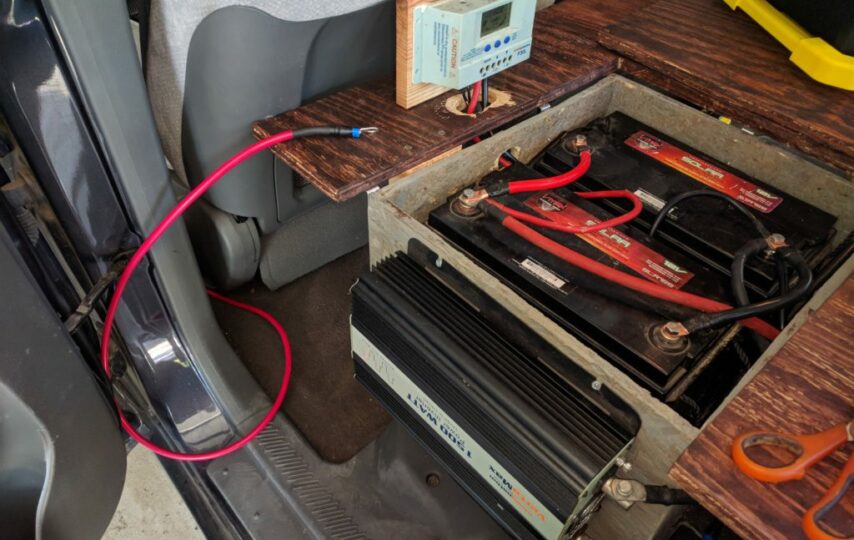The question is how you should set up your dual battery system. Permanently connected or only when charging? With or without a charger? We consider these cases and describe what the individual connection types mean.
Permanent parallel connection without disconnection and charging technology
Often favored because it is simple, cheap, and robust, it is the original solution of all dual battery systems. Sufficiently thick cables fitted between the poles of the batteries were done. The capacity has increased by the individual capacities with minimal effort. All consumers now have enough power, fed from two batteries, available. In an ideally designed system, each battery now only discharges half as fast. In return, the vehicle’s alternator must charge both batteries, which also happens in parallel, just like the current draw. If necessary, a larger alternator can be installed.
How this solution can work well
For this simple double-battery system to work well and safely, you should only use two batteries of the same type. So wet lead acid or AGM. Gel batteries are out of the question because they are not particularly suitable as starter batteries. Coupling with battery types other than lead acid can lead to very unsightly and dangerous results, so stay away from it.
Using two absolutely identical types of the same age is strongly recommended. It would also work with different capacities, but as explained above, this accelerates aging. Since, in most cases, one battery will be a classic wet lead-acid starter battery, the type of the second battery is specified. Deep-cycle consumer batteries should not be mixed with less deep-cycle starter batteries.
Loss of voltage problem
The battery away from the charging source receives a slightly lower charging voltage than the closer battery. The reasons for this are the cable length and contact resistance at the contacts, which cause the voltage to drop further and further as the distance increases. The effect can be reduced with sufficiently dimensioned cables, the shortest possible cables, and clean, flawless connection points, but it is there. With the usual dual battery systems in off-road vehicles, where only two batteries are used that are placed directly next to each other, this unbalanced charge is an effect that can be neglected. Nevertheless, you can optimize the condition with a balanced charge.
But if you have a larger vehicle, more than two parallel batteries, or longer cable runs, you should take care of that. In the simplest case, you change one connection of the generator or the charger to the other end of the battery, then you already have a better-balanced charge. If you ensure that the number, length, and cross-section of all connection cables between the batteries are the same so that the same voltage potential is everywhere, you will achieve a balanced charge.
The left picture shows the problem with increasing cable length between the generator, which generates the charging voltage UG, and the voltage at the batteries decreases. Even the voltage US at the starter battery S is slightly lower than at the consumer battery UV.
Please note that other types of connection come into play with more than two batteries to achieve a balanced charge.
Advantage: Simple and cheap
The clear advantage of this solution is the simple installation and the low costs. The cables should be short and sufficiently dimensioned and the crimp connections of the cable lugs must be professionally executed.
It requires no operation and is always available. Even if one of the other dual battery systems is used, this system can always be used in an emergency. With the clever use of switches, the other types of coupling can also be converted into this variant simply by means of a switch and without conversion.
Disadvantage: defective battery
The greatest danger of this solution is an unnoticed battery defect. In this case, both batteries can discharge in a very short time. Then you no longer have any starting current available. That leads to the next disadvantage.
Disadvantage: Manual monitoring
In operation, everything depends on you and your consumers. Ideally, these have an automatic switch-off when the voltage falls below a certain value in order to protect the batteries from deep discharge. As a reminder, the final discharge voltage of a 12V battery is 10.5 volts or 1.75 volts per battery cell. If the voltage drops further, the battery is dead or at least permanently damaged. This double battery system, again, causes the problems that have just been described.
Therefore, voltage monitoring is advisable. You should switch this in such a way that it does not permanently display the voltage because it consumes electricity itself. It is best to give the instrument a button that only displays the voltage if you wish. You should regularly check the voltage while stationary in order to detect undesired discharging at an early stage. If this is the case, immediately disconnect the batteries and charge the starter battery if necessary.
Disadvantage: battery types
Since at least one battery will be the starter battery, the whole thing ends with two starter batteries. However, they are designed to deliver high currents (starting) briefly but do not cope with long or slow discharging, possibly with low currents. The battery for consumers is therefore used incorrectly, which causes it to age faster.
In addition, most charge controllers in non-stop-start vehicles are only capable of charging lead-acid batteries. You do not master the charging curves of other battery types. Cycle-resistant consumer batteries must be charged longer and with a higher voltage, for which the driving times are usually insufficient.
Parallel connection with automatic disconnection without charging technology
This is certainly the most common variant. Formerly realized primarily by relays, there are various electronic-based isolating circuits that differ.
Cut-off relay
As soon as the alternator turns and emits a voltage, this is present at its contact D+. The isolating relay is connected and switches on as soon as voltage is applied. It connects the plus poles of the two batteries, and the charging current can flow to both batteries.
If the engine is switched off, the relay disconnects the batteries. Consumers now draw their energy from the second camper battery, and the starter battery is spared. Unless consumers are also used that are connected to the starter battery via the vehicle’s electrical system. Classic examples of this are the radio or the ventilation, especially with water parking heaters (water heating).
The isolating relay is a very inexpensive solution and usually works reliably. But it can have pitfalls. The older campers among us may still remember the D+ problem with these relays. While the starter was still rattling and the alternator was turning, the voltage was already at D+. The relay connected the batteries together. The wise user thought of that and put a fuse between the batteries, which hopefully blew. In the worst case, the fuse was missing, and something between the two batteries melted or even burned down. Usually, a cable or the relay, since the starter drew several hundred amps of current via this connection.
The relay could still get too hot and stick if nothing burned through. Then it no longer separated, of course unnoticed. And the starter battery was already in danger of being robbed of its power by the cool box, parking heater, and smartphone.
Another problem with the relay is that it allows current to flow in both directions. This leads to at least one ugly, if not fatal, problem. If the engine runs at a low speed, the vehicles’ consumers may consume more electricity than the alternator can supply. This usually goes unnoticed because the starter battery helps out here. However, if the second battery is connected to the starter battery, it is also used as a power supplier. This way, it can be unloaded unnoticed, especially when the travel time for loading is insufficient.
Advantage: Inexpensive, basically robust
You can’t get an automatic disconnect any cheaper if a proper installation is done with fuses, a good and widespread installation. If you don’t trust the automatic system, you can also operate the relay manually with your switch. If you do it cleverly, you use a button and a second relay as a holding relay to switch the first one. So you can turn on the connection relay manually, and when you turn off the engine, it disconnects itself.
Advantage: no voltage drop
A reasonably sized relay will produce almost no voltage drop, so it is considered neutral for charging.
Disadvantage: Current flows in both directions
The relay is a switch. It allows current to flow in both directions. When idle, the consumer battery can also be discharged via the vehicle consumers.
Isolation diodes
After the relays came the isolating diodes. These had the charming advantage of being a one-way street for the current. It can only flow in one direction, in this case, from the alternator and starter battery to the secondary battery. Nothing flows in the other direction. The problem seems solved. However, this variant has another problem. The voltage drop across the diodes can be up to almost 2 volts, depending on the diodes and the charging current. This is far too high a loss for a reasonable charge. There is a trick to compensate for this. Most diode isolation systems have a balancing diode that regulates the alternator to a higher voltage. But that can lead to problems elsewhere since the voltage is raised for all systems. Another intervention in the increasingly sensitive and complex onboard system. The higher the charging current, the hotter the diode gets. This is, of course, wasted power. Another electronic, low-loss isolation, the MOSFET transistor, can remedy this.
Advantage: Current only flows in the direction of the consumer battery
In contrast to the relay, the consumer battery is protected from discharging via the starter battery when the engine is running and switches off.
Disadvantage: High voltage drop
The isolating diode generates the highest voltage drop of all isolating systems. Most isolating diode systems compensate for this by raising the onboard voltage. However, this can have negative consequences for modern vehicles with electronics.
MOSFET transistors
Since the isolating diodes have some disadvantages, people looked around for an isolating technique that would hardly cause any voltage drop and power loss. MOSFET transistors are just right there. You can switch high power very quickly. There are disconnect systems that can switch up to 300 amps. They have almost no power loss and, like the diodes, do not allow any current to run back in the direction of the starter battery.
Advantage: Safely switches high power without significant loss of voltage
MOSFET transistors also switch through high power quickly and safely. Gluing, as with the relay, is not possible. The voltage drop is so low that it has no negative effect when charging.
Advantage: Current only flows in the direction of the consumer battery
Just like with the isolating diodes, the current can only flow in one direction.
Disadvantage: cost
A MOSFET circuit breaker is already priced at over 100 euros.
B2B loader
The previous solutions connected the two batteries. The optimal charge has not yet been taken into account. At this point, sensible charging significantly impacts the life of the battery. All lead-acid batteries (Wet, AGM, Gel) are close in terms of charging curves and process, but there are differences. Especially when it comes to the phase after full charging. A simple alternator charge controller usually does not master these more sophisticated charging curves.
The battery-to-battery loader is a separation technology and charger in one. It is a high-power consumer, so it always gets the maximum charge current left. Intelligent systems monitor the state of charge of the starter battery. If this is not fully loaded, the B2B loader holds back. As soon as the starter battery is fully charged, it draws as much current as possible and uses it to supply the second battery. In addition, a 12V battery charger is integrated that can be set to the different battery types. This is particularly important for gel batteries, but AGM batteries also benefit from it.
The B2B loader is also available as an A2B loader (alternator to the battery). This one goes a step further. It is connected between the generator and both batteries. It charges both separately and with the optimal charging curve.
Advantage: Optimal charging
The sole purpose of a charger is to charge batteries optimally. If you use the correct charger for your battery or the correct charging setting, you will get the best result depending on the driving and charging times.
Advantage: charging and separation technology in one
A B2B loader is two devices in one. It disconnects and loads.
Disadvantage: cost
Such a device is already several hundred euros and is therefore certainly one of the most expensive variants. The price increases further if other charging sources (solar, shore power) can also be connected via the device.
Conclusion
A complex topic that can be viewed from many sides and where many complex processes occur. Everyone swears by their favorite solution somewhere, the only question is whether empirical values with other systems are available for comparison.
Anyone who has something against electronics and too much technology in the car should consider whether this could mean an advantage here and there. Planned and wired accordingly, in case of doubt, the simple solution of manual or even permanent coupling can be created from the high-tech solution by simply switching over to classic mechanical switches. So you can have the best of both worlds. As long as the electronics work and they do for a long time, you take advantage of them. Especially when it comes to charging technology, if it fails, you can fall back to the manual solution if necessary.
Speaking of failing, when doing things, always fail? Of course, when you need them most. If you are going somewhere where the starter battery is also life insurance, you should provide some separation. If the batteries are in the right place, you won’t get the car started even if you push it because today’s alternators are externally excited. This means that they need electricity from the battery at the beginning to generate electricity.
Those who opt for charging electronics should not save at the wrong end. We recommend, for example, systems from the maritime sector, in which fail-safe technology is much more important than on the road and off-road. In addition, these devices are also insensitive to shocks and water. If additional charging sources such as solar panels or shore power are added, you can no longer avoid additional charging technology. So, consider whether you want to use such charging sources later when purchasing.
Any installation should be performed by a professional. On the one hand, he can dimension the battery system correctly so that it not only works but also supplies electricity for a sufficiently long period. On the other hand, he can carry out the installation professionally and reliably. The danger of a cable fire should not be underestimated.
Dual battery system tips
- With a load switch (also called a NATO bone or kill switch), you can switch both batteries together in an emergency when they are otherwise separated. If, for example, the starter battery is defective, you can switch the consumer battery into the onboard network to be able to start. It should handle at least 300 amps. This circuit bypasses all other technology around the double battery system, corresponding to the permanent coupling without a charger.
- With a 0-1-2-3 switch in the ground connections of the batteries, you can activate both (1+2), one or the other (1, 2), or both (0). This is always helpful when the vehicle needs to be de-energized and disconnected from the batteries, for example, during welding work.








